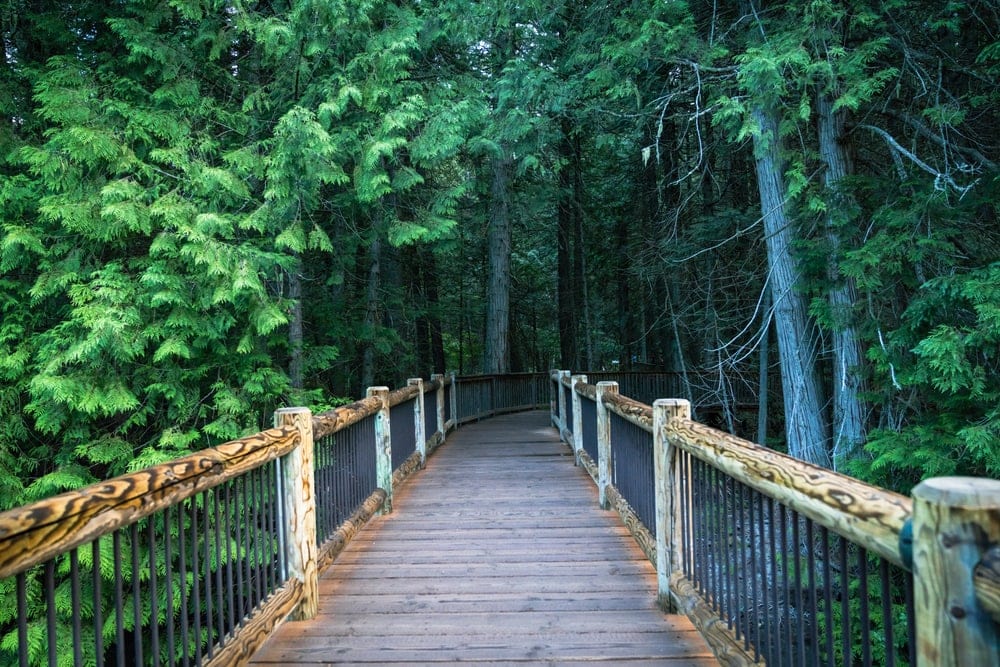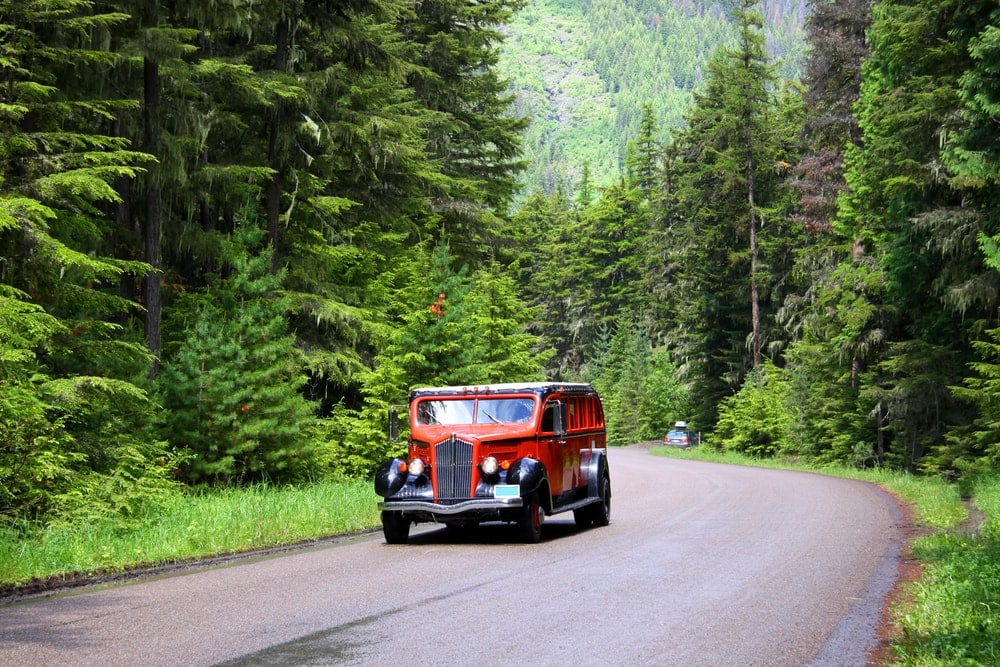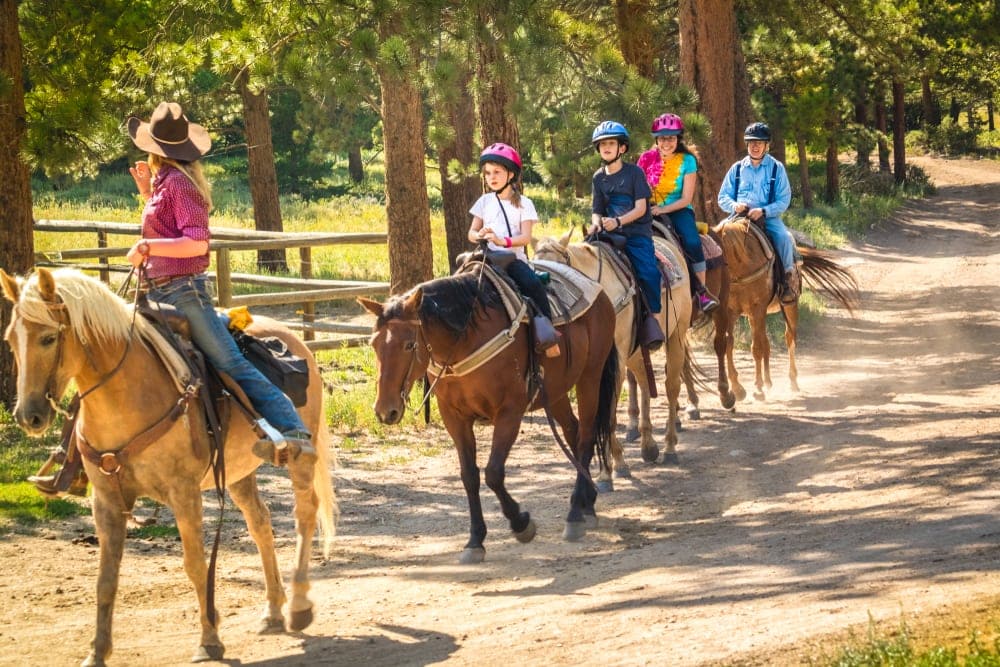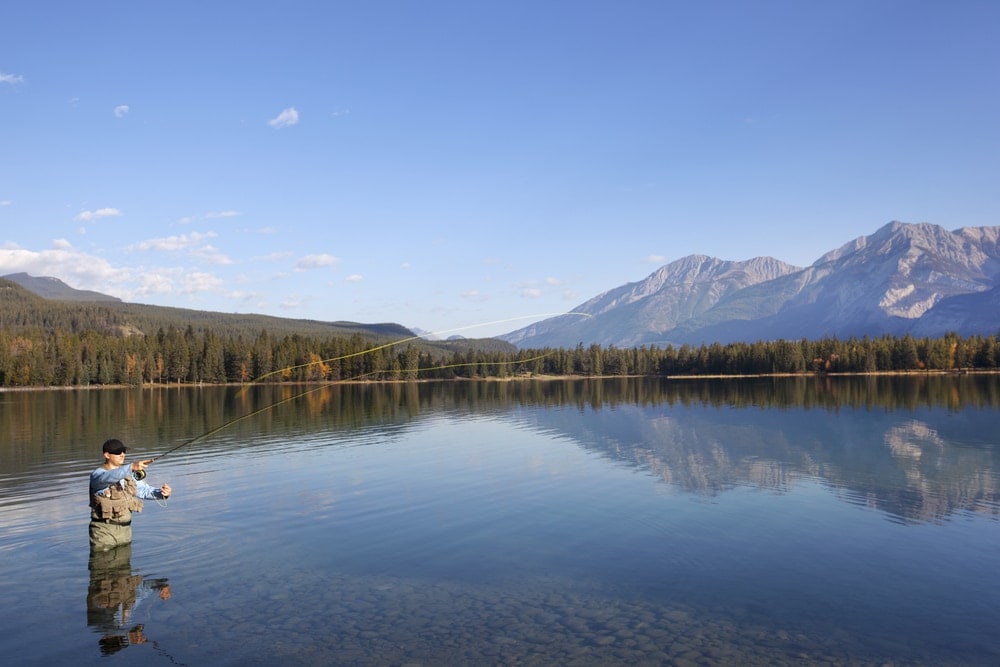
Glacier National Park is one of the most beautiful parks in the U.S. National Park system. It is a hiker’s paradise, hosting all kinds of opportunities for camping, wilderness adventures and quiet areas for solitude.
Although hiking is probably one of the activities the park is best known for, it isn’t the only attraction. In this article, we will explore just about everything you can do in this beloved national park, including taking a boat ride, going on a scenic drive and watching for wildlife. In Glacier, there is something for everyone.
Our Top 5 Favorite Hikes in Glacier National Park
Since hiking is the most popular activity in the park, we will start with our list of featured hikes. Of course, there are many more hikes than these, but these are our top five favorite hikes. They cover a range of levels and types of terrain in Glacier National Park.
1| Highline Trail

- Length: 11.6 miles (18.7 km)
- Location: Logan Pass or the Loop
- Key Features: Panoramic views, wildflowers, wildlife
Highline Trail is one of Glacier’s most popular trails for a good reason. It gives you some of the best views of the park. They are stunning panoramas that will stay with you long after you complete the almost 12-mile (19 km) hike.
There isn’t a lot of elevation gain since you start at quite a high elevation. However, if you prefer going slightly downhill to uphill, you might want to start from Logan Pass instead of the Loop trailhead.
2| Avalanche Lake

- Length: 4.6 miles (7.4 km)
- Location: From the Trail of the Cedars
- Key Features: Woodland walk, wildlife
Avalanche Lake is a different experience from most of the other popular hikes in the park. Instead of featuring stunning panoramic views of mountain peaks and snow-capped spires, take a walk through a dense forest. In addition, the hike has very little incline change. Instead, you walk along Avalanche Creek.
The hike begins at the Trail of the Cedars. That hike is a popular, easy loop trail that accommodates a range of levels. Take the boardwalk trail into the forest until you get to Avalanche Gorge and continue to follow the signs for Avalanche Lake.
3| Grinnell Glacier

- Length: 10.6 miles (17.1 km)
- Location: Grinnell Glacier Trailhead or Lake Josephine
- Key Features: Panoramic views, proximity to a glacier, wildlife
Grinnell Glacier features almost everything you could want from a glacial hike. It includes views of cascading waterfalls, deep emerald and sapphire blue lakes, swaths of wildflowers in the spring and summer and alpine scenery.
There is also a high likelihood of spotting wildlife like mountain goats and moose. There is also the chance of running into a bear on this trail, so be properly prepared. Since the trail is another one of the more popular ones in Glacier National Park expect fellow hikers to share the trail.
4| Iceberg Lake

- Length: 9.7 miles (15.6 km)
- Location: From Swiftcurrent Motor Inn
- Key Features: Proximity to a glacier, alpine views, alpine lake, wildflowers
The hike up to Iceberg Lake gets a strenuous rating according to the national park service observers. The total ascent to the lake brings you up 1,200 feet (365.8 m). Plan between 5 to 7 hours for this epic hike.
The hike starts on the same trail as the Ptarmigan Tunnel. On your way to the beautiful glacial lake at the top, you will walk through some grizzly bear territory. Be careful while on this hike, making plenty of noise, hiking in groups, and bringing bear spray. Check with local rangers for news of wildlife encounters.
5| Apikuni Falls

- Length: 2 miles (3.2 km)
- Location: Apikuni Parking Area
- Key Features: Waterfall views, wildflowers
If you are looking for a great hike to get stunning waterfall views, then you will be significantly rewarded on this hike. The trail is moderately trafficked, meaning you won’t be swamped with people during the busier seasons in the national park.
The trail is best from June through October. You can get to the hike on Poia Lake Trailhead and in the Apikuni Parking Lot. If you decide to start from the Apikuni parking lot, keep in mind that there is limited parking of about 12 cars.
Scenic Drives in Glacier National Park
There are plenty of beautiful roads and routes you can take through the park. However, there is only one genuinely scenic drive that you can take throughout Glacier National Park. Luckily, it is one of the best scenic drives in all of America, giving you some of the most breathtaking views you can get from the car’s window.
1| Going-to-the-Sun Road

- Estimated Time to Complete: 2-3 hours
- Length: 50 miles (80 km)
- Must-See Stops: Hidden Lake Overlook, Wild Goose Island Lookout, Jackson Glacier
Get on the road in Glacier National Park by taking the St. Mary entrance or through the East entrance. The most popular entrance onto the scenic drive is to the west by the Apgar Visitor Center. The visitor centers are also an excellent time to stop and check the status of the road. Any snow in the park will likely mean at least partial closures to the road.
Once you get on the road, you almost immediately start climbing up the mountain. The views only get better the further you go up. Just be aware that this road isn’t just your straightforward road.
It is a two-lane road that barely constitutes a two-lane road. Vehicles only under 21 feet (6.4 m) in length, 8 feet (2.4 m) wide and 10 feet (3.0 m) tall can be on the Going to the Sun Road. Do not drive recklessly along the road.
Since the road is narrow and two-lane, a fender bender accident or wildlife crossing the road can cause lengthy delays. Make sure to pack enough water and food to keep your family comfortable if you have to wait for an accident to clear.
Best Things To Do in Glacier National Park

Share this Image On Your Site
<a href="https://outforia.com/what-to-do-in-glacier-park/"><img style="width:100%;" src="https://outforia.com/wp-content/uploads/2021/11/What-to-do-in-Glacier-National-Park-Infographic.jpg"></a><br>What To Do In Glacier Park Infographic by <a href="https://outforia.com">Outforia</a>Glacier doesn’t only have hiking and a beautifully scenic drive. It also boasts many gorgeous glacial lakes and fun activities for kids to burn off some energy.
1| Best Things To Do in Glacier National Park for Seniors
There are different levels of ability that come to the park every season. Gratefully, the management for the National Park has thought about accessibility for all. If you have mobility issues, these options will be perfect for you.
Trail of the Cedars Boardwalk

The Trail of the Cedars is a raised boardwalk or paved path that takes you through a forest of ancient red cedars and a mix of western hemlock. It is a 0.6-mile path, making it a beautiful, manageable trail for both the elderly and children to use. There are also plenty of seating options provided along the trail for those needing to take it in smaller chunks.
The trail starts from the Avalanche Creek parking lot and trailhead. During the spring, it is likely you will see waterfalls in the forest as well. There is only an elevation gain of 60 feet (18.3 m) along the trail. Keep in mind that since this is only 5.5 miles (8.9 km) away from the frequented Lake McDonald Lodge, and it’s a very popular trail, parking during the peak travel season can be difficult.
Explore the Park on a Bus Tour

If hiking through the park isn’t an option for you or your family, you can take a bus tour. These interpretive tours give you the chance to see the vast majority of the park, stop off at some of the best scenic areas and all in the comfort of an air-conditioned coach.
One of the more popular bus tours is offered through Sun Tours. They use coaches that can hold 25 passengers at a time. Their tours don’t only take you through the must-see parts of the park, but they also highlight the ancient Blackfeet culture that these mountains once housed.
Daily service with Sun Tours from West Glacier, St. Mary, East Glacier and Browning throughout the peak season.
The other primary tour service offered in the park is through Xanterra Parks and Resorts. They offer tours and scheduled transportation through the park in their enigmatic and historical red tour buses.
2| Best Things To Do in Glacier National Park for Kids
Your kids might love to hike, but they might also need something more to keep their attention on a long day of walking. Luckily, the park offers all kinds of other activities to capture your children’s attention.
Search for Wild Huckleberries (Followed by Eating Huckleberry Ice Cream)

Huckleberries are one of the primary edible foods within Glacier National Park. They come from the wild blue huckleberry (Vaccinium sp.). In late summer, these plants produce dark purple berries that have a tart flavor. Watch out, though. Humans aren’t the only ones that enjoy these dainty snacks. Grizzly bears are also huckleberry fanatics.
When you visit the park, each visitor is allowed to pick one quart of huckleberries per day. They should only be for personal consumption.
Outside the park, the surrounding communities have done a lot with these little berries. Once you have exhausted your daily limit for huckleberry hunting, find some amazing huckleberry ice cream, jam, and so much more in any of the towns bordering the national park.
Go Horseback Riding

Another unique way to experience the park that gets your kids active but off their tired feet is horseback riding. Swan Mountain Outfitters offers guided horseback rides in the park during every season, barring winter. They start from either Apgar, Many Glacier or Lake McDonald.
They also offer drop camp services which can be quite an enjoyable alternative to backpacking into the backcountry. You will need to coordinate with the company in advance and obtain a backcountry permit to arrange this.
3| Best Things To Do in Glacier National Park for Day Visitors
There is so much to see and do in this expansive park that it can be difficult to choose if you only have one day to visit. We would recommend a mix of activities. You could couple some shorter hikes with one of the activities below to get a thorough taste of the park.
Wild Water Rafting

If you only have a day to spend in this incredible national park, you might as well do something exhilarating! A rafting tour allows you to view the park from a unique angle and takes you through some otherwise completely inaccessible sections.
Several rafting companies operate in the park. They offer commercially guided rafting trips through Middle Fork and North Fork via the Flathead River. These areas lie within the Flathead Wild and Scenic River designation and are managed by both Glacier National Park and Flathead National Forest.
Even on the hottest days of summer, the water is bone-chilling and refreshingly cold. Take a dip and cool off before getting back in the car.
Spend Time on Lake McDonald’s Beach

Not everything has to be about movement when you visit a beautiful outdoor landscape like this one. If you need some time to relax and enjoy yourself before moving on, take some time on the shore of Lake McDonald.
It is the largest lake in the park, formed because of direct glacial carving. It is nearly 500 feet deep (152.4 m). Because of its depth, it is at near-freezing temperatures all year round. That means you might want to stay on the beach no matter how tempting the water looks.
Best Photographs in Glacier National Park
Glacier is arguably one of the most photogenic locations in the world. Around every bend and curve, you get views that you could only imagine before entering the park. However, there are certain spots that are known for their incredible beauty and ability to stand out in a photograph. These include:
- Wild Goose Island
- Lake McDonald
- Swiftcurrent lake
- Grinnell Glacier
- Avalanche Gorge
- Iceberg Lake
- Hidden Lake Overlook
Water Activities in Glacier National Park
One of the other things Glacier National Park has a reputation for is its many beautiful lakes. Although not all of them are boat accessible, there are quite a few of them that you can enjoy spending time on in a boat, kayak or canoe.
1| Boat Trips in Glacier National Park

There are plenty of large lakes in Glacier National Park, many of them formed by the melting of the same glaciers the park is currently known for having. Boat tours with guides and commentary are available on quite a few of these lakes, including:
- Many Glacier
- Rising Sun
- Two Medicine
- Lake MacDonald
There are also optional guided hikes that you can take while participating in some of these lake cruises. You can go on this combination of hiking and boating tours on the lakes:
- Many Glacier
- Rising Sun
- Two Medicine
Regulated by national park rules, only verified boating agencies can lead these tours. In Glacier, that business is the Glacier Park Boat Company. Book tours online or when you get to the park. Reservations fill quickly but there’s usually options available.
There are also cruises available on the Canadian side of the park. Waterton Inter-Nation Shoreline Cruise Co. is one of these. They operate from the launch International on the northern border of the park in Canada. They primarily operate on Waterton Lake.
2| Boat Rentals in Glacier National Park

Renting a boat in Glacier National Park is another option if you decide you don’t want to stay on a cruise tour. Glacier Park Boat Company offers small boat boats available at certain lakes across the Park. These include:
- Apgar
- Two Medicine
- Lake McDonald
- Many Glacier
Fishing Opportunities in Glacier National Park
Glacier is not the one you would want to frequent for a great fishing experience out of all the national parks. There are many lakes throughout the park, but they are at such an altitude that they lack the oxygen levels and nutrients necessary to spawn large fish.
That results in quite a few entirely fishless lakes. Then, there are other lakes where the fish are practically starving and will gulp at your finger given the opportunity.
The best lakes for fishing in Glacier National Park are often found in the backcountry. You will need to get to them by hiking into the backcountry. Keep in mind that going anywhere in the backcountry of any National Park requires a special permit. Make sure you apply for this as soon as you start planning your trip.

The backcountry lakes where the fishing ranges from mediocre to excellent include:
- Avalanche Lake
- Bullhead Lake
- Hidden Lake
- Fishercap lake
- Logging Lake
- Lake Josephine
- Snyder Lake
- Red Rock Lake
- Trout Lake
Be sure to approach these trips with plenty of respect and planning. Reference contour maps to understand the elevation gain you will experience on the way to the lake.
Luckily, when fishing in Glacier National Park, you do not need a fishing license as long as you stay within the park’s boundaries. However, you will need a Montana fishing license if you go outside the park’s borders or fish in the rivers along Glacier’s southern and western borders.
Generally, the fishing season in the park ranges from about the third Saturday in May and extends through the last day of November. Keeping fish is quite discouraged within the park, but it isn’t illegal. Exceeding your possession limits IS illegal.
Be sure to check up on the latest park fishing regulations to know your possession limits of various fish species. Also, fishing for bull trout in the park is illegal, and they must be immediately released if you do catch them.
Glacier National Park Visitor Centers
There are three primary visitor centers in Glacier National Park. These include:

1| St. Mary Visitor Center
If you come in from the East side of the park, you are closest to St. Mary Visitor Center. It is adjacent to the St. Mary Entrance that will take you on Going to the Sun Road. Outside of the park, it is near to the town of St. Mary on U.S. Highway 89 within the Blackfeet Indian Reservation.
This visitor center has a wide range of facilities, hosts ranger-led activities, a bookstore, interactive exhibits, and a wilderness permitting station. It is open every day from late May through early October.
2| Apgar Visitor Center

Apgar Visitor Center is located next to the four-way stop that features the intersection between Camas Road and Going to the Sun Road. It is about 2 miles (3.2 km) north of the West Entrance of the park. It is near the town of West Glacier, Montana.
The park features very similar facilities and activities as St. Mary’s, without the wilderness permitting capabilities. The building and construction zone around it is a pioneering site for sustainable construction. This station is open from mid-May into the middle of October. There are sometimes staff present on weekends during the off-season.
3| Logan Pass Visitor Center

Logan Pass Visitor Center is located in the middle of the park, about a 1.5-hour drive from Apgar Visitor Center and 1 hour from St. Mary Visitor Center. It features ranger activities and some facilities. However, since it sits at the highest point on the Going to the Sun Road, it is only open during the peak season when the road is open.
Ranger Programs

There are many ranger programs offered throughout the year in this popular park. From astronomy classes to park-run boat tours, the rangers guide you through all facets of the park.
As in any of the American national parks, the children’s programs are pretty popular. They lead Junior Ranger Discovery Talks and Explorers Walks several times a week to try and allow any child who wants to earn their Junior Ranger badge to get it from this park.
The experiences the rangers lead range depending on the time of the year, the climate and which visitor center. It is best to look up your dates to find out what’s going on during your trip before making any solid plans.
Wildlife to Watch Out For at the Glacier National Park
Glacier National Park boasts so much space and open expanses of protected land that it cultivates quite the list of animal species. Some of these might be incredible to see from afar, but you should respect their distance. That is, namely with the grizzly bear.

Otherwise, the park’s rangers will advise you to keep safely away from the animals in the park. That isn’t only for your safety. It also helps ensure the continued survival of the animals.
Some of the most recognized mammal species you can find in Glacier National Park include:
- Mountain goats
- Bighorn sheep
- Beavers
- Coyotes
- Pikas
- Canadian Lynx
- Deer (various species)
- Elk

An incredible array of avian species populate areas from the mountain peaks to the green valleys. Certain rare migratory species make their way through the park in the spring and fall. Others are year-round occupants of the park. The species you should look for in the park includes:
- Blue herons
- Golden eagles
- Canadian geese
- Peregrine falcons
- Tundra swans
- Great horned owls
- Ospreys
Links to Useful Resources
When you visit almost any of the National Parks in the United States, the National Park Service will have the most up-to-date information and resources for you. Their website will give you access to the maps you need for hiking and plenty of other day-by-day information.













